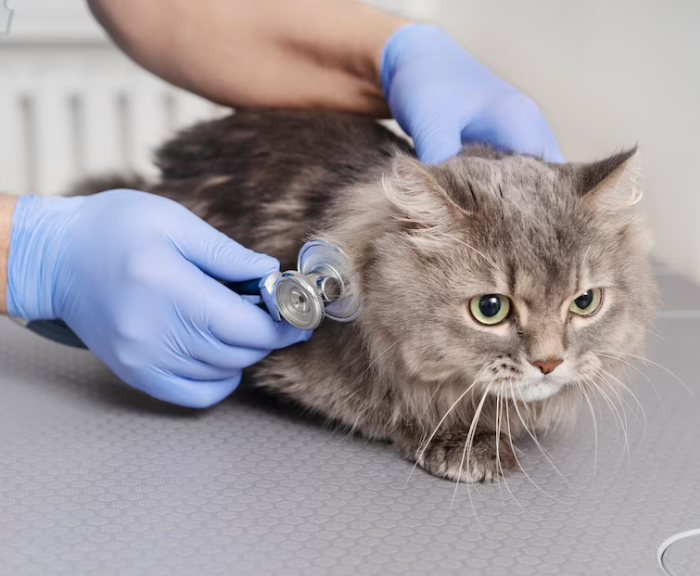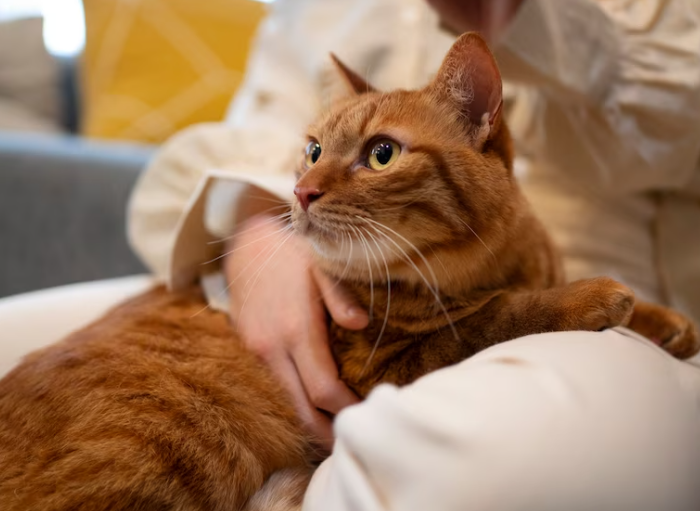2023-09-04
Cats are very clean animals, who spend a big part of the day in grooming. Finding a warm and soft spot at home and taking care of their coats is usually one of the favorite activities of our feline friends. Since our cats spend much time keeping their coats neat and well-groomed, it is our responsibility to take care of them too. As responsible cat parents, we should keep track of our paw friends’ health, which also includes supervising the condition of their coats and skin.
Cat skin can be very sensitive and prone to various conditions, which we should not take lightly if we want to provide our feline friend with living conditions as perfectly as possible. There are some skin issues considered common in cats, whose symptoms we should learn to recognize. That way we will be able to take action in a timely manner and ensure that our paw friend is well taken care of.

The sebaceous glands that can be found in our cats’ skin help remove excess moisture and dirt and keep their skin clean and healthy. If our paw friend has developed some skin problems, certain symptoms will be present. Common symptoms of skin issues that you should keep eye on are:
• Redness;
• Bald areas;
• Dryness;
• Scabs;
• Acne;
• Discharge;
• Unpleasant odor;
• Matted hair;
• Lumps
Your cat is also likely to change their normal behavior and grooming routine. Deviations in their behavior you may notice include:
• Excessive scratching;
• Biting of the skin;
• Excessive licking of the skin or certain areas.

Some owners are likely to neglect the regular parasite control their feline friends should go through, as they do not perceive fleas and ticks as problems serious enough to take precautions. In fact, fleas and ticks can cause serious problems for your cat’s health, and skin issues as a result of skin allergy to these parasites are some of them. Not to mention that fleas and ticks can transfer through their bite many infections on your kitty.
Symptoms you may notice in your cat if they are infected with fleas and/or ticks are:
• Inflamed/irritated skin;
• Excessive scratching;
• Red patches;
• Scaly skin.
The most common causes for flea or tick infection are exposing the cat to these parasites in an outdoor environment or having another pet at home who has transferred them to your cat.
The best thing you should do if you notice parasites on your cat’s skin or some of the symptoms listed above is to bring him/her to a veterinarian immediately. They will prescribe medication, which may include antibiotics as well. In case there is a tick the veterinarian will remove it and will treat the infected area.
If your cat does not spend the whole day indoors, ensuring they regularly undergo parasite control is essential for their health.
Simply put, cat dermatitis is an inflammation of the skin.
The most common causes for this condition are parasites such as fleas, environmental factors as well as allergies (usually to certain food).
Based on the cause of the issue the treatment may include medication, including antibiotics, antihistamines, changes in the diet, and ointments.
Cat rash describes color or texture changes of the skin. It can be perceived as a symptom of dermatitis or listed separately as a skin problem, as the cause may be different. Rashes can be caused by different factors, including parasites, infections, and allergies, but also more serious health conditions such as cancer or autoimmune diseases.
Based on what the cause is, the treatment may include antibiotics, dewormers and other types of medication, antihistamines, as well as chemotherapy. If you notice rashes on your paw friend’s skin, you should not panic. Think about any recent changes in your cat’s food and environment, as an allergic reaction to environmental stimuli or food is usually the most common cause.
You may be surprised to know that cats can have acne too. Cat acne is a condition, which is characterized by hair follicles producing too much keratin, which causes them to get plugged. Usually, acne is not a serious condition and can be easily treated with proper medication or by changing the diet and lifestyle.
The most common causes of acne are anxiety and stress, hormonal changes, irritation from being in contact with certain materials like plastic food/water bowls as well an unsuitable diet.
Mange is a skin condition in both domestic and wild mammals, such as dogs, cats, livestock, cougars, foxes, and bears, which is caused by mites. The so-called Demodex mites (Demodex is a genus of very tiny mites, living near hair follicles of mammals) are common for most cats and are not considered dangerous for them.
However, if a cat’s immune system is weakened, these mites can cause different skin issues such as hair loss, and irritation and also lead to an allergic reaction. Mites are part of the arachnid subclass Acari, which is why mite infestation is also known as acariasis.
If you think that your feline friend may have mites, you should bring him/her to the veterinarian's office for examination. Proper treatment, based on the type of the mites, will be prescribed.
Skin issues in the ear area are often caused by an infection, whose symptoms typically are scratching and discharge. Infections can be caused by different factors and allergies are among the most common ones.
Ear mites can often be found in stray cats or young kitties. They cause a discharge from the ear canals of a dark color.
How the ear skin issue will be treated depends on the cause- if it is an infection, then the cause for the infection should be determined first; if it is ear mites, then topical medication is likely to be prescribed.
Ringworm is a skin infection, caused by a fungus and not by worms, as the name implies. If you notice flaky and red areas, lesions as well as unhealthy-looking hair (thinning), then your cat may deal with Dermatophytosis. This skin disease is usually transferred through wounded skin by infected surfaces or animals. Similar to other infections, the weakener your cat’s immune system is, the bigger the chance is for him/her to get infected.
You should not worry, as these types of infections are absolutely treatable. You should bring your paw friend to a veterinarian for a checkup and topical or antifungal medication is likely to be prescribed by them.
Just like humans, cats can be allergic to various factors in their environment, including food and pollen. If you notice your cat excessively scratching, chewing, and over grooming their coat, then they may have an allergic reaction to an environmental stimulus. Hair loss can be another symptom of an allergy. Medication, changes in diet, and any supplies in the surroundings that may have caused the allergy could be part of the treatment.
If your paw friend starts losing hair, this may be a symptom of an underlying health condition, infection, or allergy, and requires a veterinarian examination. Based on the cause, antibiotics, corticosteroids or other types of medication may be prescribed.
Dandruff and dry skin in general can be caused by different factors, including allergies, unbalanced diet and lack of nutrients, or parasites. The treatment may require environmental changes, changes in diet, cat shampoo, or medication. Sometimes the problem can be easily resolved, while other times veterinarian examination is required.
Erythema multiforme (EM) is a skin disease, that can affect cats and dogs with or without the mucous membrane to be involved. This skin problem is rather uncommon and can be divided into two groups based on whether there are mucocutaneous lesions or not. Erythema can be caused by many factors, including but not limited to infections, allergies, and parasites. The cause of the issue is crucial for the treatment, which may require medication or the allergen to be removed.

In order to help the veterinarian quickly determine the cause of the skin problem and prescribe accurate treatment, you should be able to provide information about your cat and their living environment. It would be helpful if you could let the vet know:
• whether your cat lives indoors or outdoors (or both);
• what type of food you feed him/her;
• if there are other pets in the household;
• if there were any recent changes in the environment including their food and litter;
• when was the last time your cat underwent parasite control;
• for how long have the symptoms been visible;
• have the symptoms spread or rather remained in the same area;
• if there are any behavioral changes in your cat, besides the skin issues, such as lack of energy, loss of appetite, and irritability.
As responsible owners, we should not neglect our pets’ health, but ensure that they live in a safe and loving environment and regularly bring them to veterinarian checkups.